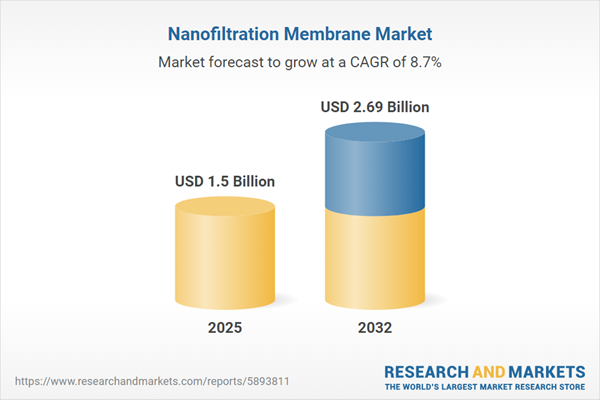Speak directly to the analyst to clarify any post sales queries you may have.
The nanofiltration membrane market is advancing as organizations seek adaptable filtration technologies to address resource management, compliance, and sustainability challenges in core industries. Senior decision-makers are focusing on scalable solutions that enable operational efficiency and robust regulatory strategies.
Market Snapshot: Nanofiltration Membrane Market Size and Growth
In 2024, the global nanofiltration membrane market was valued at USD 1.38 billion and is set to reach USD 2.69 billion by 2032, growing at a CAGR of 8.69%. This strong growth trajectory is propelled by rising investments and increasing deployment across industries including industrial manufacturing, municipal utilities, and residential water filtration. Market expansion is driven by rigorous environmental regulations and heightened demand for innovative, sustainable filtration methods. Organizations are adopting digital monitoring solutions and advanced membrane materials, positioning nanofiltration as a vital element in contemporary water management and regulatory compliance frameworks.
Scope & Segmentation
- Application Areas: Nanofiltration membranes play a crucial role in chemical processing, pharmaceuticals, biotechnology, food and beverage production, water treatment for municipalities and industries, and resource recovery operations, ensuring precise separation and alignment with regulatory requirements.
- Key Processes: These membranes support essential processes such as chemical synthesis, oil and gas extraction, fermentation, dairy applications, potable water solutions, bioprocessing, and effluent management, underpinning efficiency and environmental stewardship in diverse settings.
- Membrane Configurations: The market offers hollow fiber, plate-and-frame, spiral wound, and tubular module designs. This range allows for installations in both centralized and decentralized facilities with adaptability and future scalability.
- Material Types: Options include ceramic, composite, and polymeric constructions—namely cellulose acetate, polyamide, polyethersulfone, and polysulfone—selected for strength and performance in demanding industrial environments.
- End Users: The sector serves chemical manufacturers, food and beverage providers, municipal infrastructure operators, pharmaceutical and biotech firms, industrial water authorities, and residential water solution providers, each requiring reliable, compliant separation technologies.
- Regional Coverage: Adoption spans the Americas, Europe, Middle East and Africa, and Asia-Pacific. Market dynamics reflect local regulatory frameworks, infrastructure development, and differing investment priorities.
- Leading Companies: Advancements and supply chain resilience are shaped by DuPont de Nemours, Toray Industries, Nitto Denko Corporation, LG Chem, SUEZ, Koch Industries, Merck KGaA, LANXESS, Evoqua Water Technologies, and Pentair, who consistently drive innovation and deployment capabilities.
Key Takeaways for Senior Decision-Makers
- Advances in ceramic and composite membrane materials increase operational lifespans and maintain performance consistency in rigorous industrial applications.
- Digital analytics and automated system monitoring provide heightened visibility, enabling targeted maintenance and reducing the risk of unplanned service interruptions.
- Modular and hybrid system architectures support flexible scaling, allowing infrastructure to adapt to evolving sustainability and compliance demands.
- Nanofiltration enables organizations of varying size—from large utilities to smaller, distributed sites—to proactively meet regulatory requirements and maintain operational agility.
- Collaboration among technology providers, integrators, and research organizations speeds deployment and encourages ongoing process improvements.
- Distinct regional strategies affect market direction: regions may prioritize building new infrastructure or optimizing existing systems to enhance lifecycle value in line with local standards.
Tariff Impact: United States Policy Effects and Supply Chain Responses
Recent changes in United States tariff policy are altering procurement and production methods within the nanofiltration membrane market, particularly regarding polymeric and composite materials. Companies are developing local manufacturing partnerships and strengthening supplier networks to reduce exposure to price volatility and manage operational costs. This adaptation has led to increased evaluation of ceramic alternatives and diversification of material sourcing, fostering more resilient supply chains while maintaining steady technology advancement.
Methodology & Data Sources
This report draws on in-depth secondary research, comprehensive reviews of regulatory documentation, and financial analysis. Information from executive interviews, technical experts, and procurement-focused surveys contributed to the validity and relevance of the findings.
Why This Report Matters
- Delivers practical insights to inform executive strategies in water management, guiding resource planning, procurement, and investment decisions that align with organizational objectives.
- Clarifies regulatory and technology trends, positioning businesses to anticipate global changes and address shifting marketplace requirements.
- Supports benchmarking and R&D strategies, facilitating ongoing performance improvements and informed positioning within the nanofiltration and membrane filtration sectors.
Conclusion
Implementing advanced nanofiltration membrane solutions enhances operational resilience and supports compliance, empowering senior leaders to achieve sustainable and consistent results within a rapidly changing global market.
Additional Product Information:
- Purchase of this report includes 1 year online access with quarterly updates.
- This report can be updated on request. Please contact our Customer Experience team using the Ask a Question widget on our website.
Table of Contents
3. Executive Summary
4. Market Overview
7. Cumulative Impact of Artificial Intelligence 2025
Companies Mentioned
The companies profiled in this Nanofiltration Membrane market report include:- DuPont de Nemours, Inc.
- Toray Industries, Inc.
- Nitto Denko Corporation
- LG Chem Ltd.
- SUEZ S.A.
- Koch Industries, Inc.
- Merck KGaA
- LANXESS AG
- Evoqua Water Technologies LLC
- Pentair PLC
Table Information
| Report Attribute | Details |
|---|---|
| No. of Pages | 199 |
| Published | November 2025 |
| Forecast Period | 2025 - 2032 |
| Estimated Market Value ( USD | $ 1.5 Billion |
| Forecasted Market Value ( USD | $ 2.69 Billion |
| Compound Annual Growth Rate | 8.6% |
| Regions Covered | Global |
| No. of Companies Mentioned | 11 |









